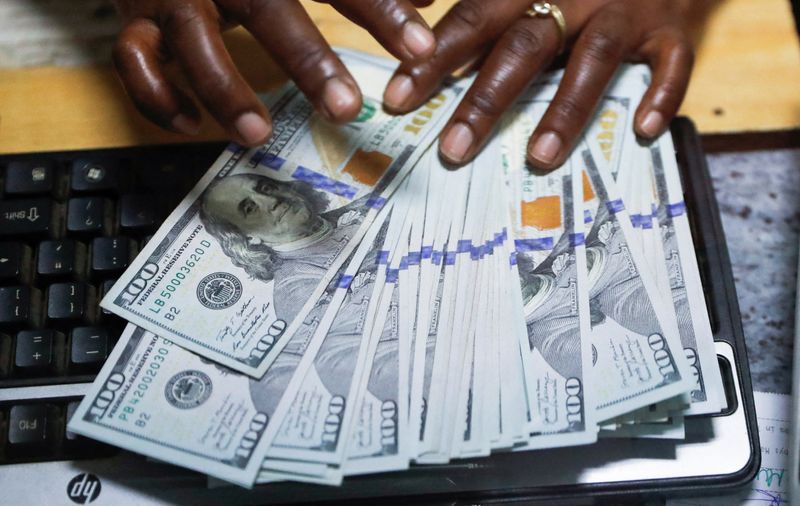By Alun John and Dhara Ranasinghe
LONDON (Reuters) - A dollar surge propelled by a strong economy, sticky inflation and geopolitical tensions have unnerved policymakers from Tokyo to Beijing and Stockholm.
The dollar is at its highest since November against other major currencies, poised for a fourth straight month of gains.
Its latest rally, following stronger-than-expected March inflation numbers that pushed back U.S. rate cut bets even further, highlights how sensitive currency markets are to relative interest rate changes.
"We track investor flows, and the dollar buying since the CPI release has been strong," said Tim Graf, head of macro strategy for Europe at State Street (NYSE:STT) Global Markets.
Here are some pressure points sparked by dollar strength.
1/ JAPAN AND KOREA
Tokyo's yen warning light is flashing.
One dollar is worth just under 155 yen, its strongest since 1990, and Japan has warned that it might start buying yen to support its value.
Even after Japan ended eight years of negative rates last month, the gap between Japanese and U.S. rates remains wide and is set to remain so for some time, keeping the yen weak. The yen, the worst performing G10 currency this year, has fallen 9%.
The dollar has risen around 7% on Korea's won in the last month alone and is at its highest in a year. Last week, the United States, Japan and South Korea agreed to "consult closely" on currency markets in a rare warning.
"A statement like this suggests if Japan's Ministry of Finance or equivalent authorities in South Korea wanted to go ahead and moderate the volatility of their exchange rate, the U.S. wouldn't necessarily object," said James Lord, head of FX and emerging market strategy at Morgan Stanley (NYSE:MS).
2/ CHINA AND EMERGING ASIA
Dollar strength is causing pain across Asia.
India's rupee and Vietnam's dong are at their weakest ever. Indonesia's rupiah is at its softest in four years and its central bank is talking about intervention although this is much more common in emerging markets.
Traders are also watching China's yuan, onshore and offshore which has depreciated much less than peers.
A weak yuan would help Chinese exporters but could encourage capital outflows.
"The offshore yuan is definitely top of the list" when it comes to Asian currencies under pressure, said Adarsh Sinha co-head Asia rates and currencies strategy at Bank of America (NYSE:BAC).
"It's one of the more popular ways to be short because it hasn't moved."
3/ EURO ZONE
The euro, trading just above $1.06, is by no means among the weakest major currencies versus the dollar. But notably, banks have recently downgraded euro/dollar forecasts.
Before the latest U.S. inflation data, markets had largely seen the European Central Bank and Federal Reserve as moving in lockstep on rate cuts. Now the ECB is expected to cut in June and an anticipated Fed cut in September has pushed the euro to five-month lows.
"If the euro continues to weaken below $1.05 and oil prices go up, then you have an inflationary tailwind, and so the ECB will have to be very careful after a first rate cut," said Societe Generale (EPA:SOGN)'s head of corporate research FX and rates Kenneth Broux.
4/ SWEDEN
Importing inflation via a weaker currency is a particular problem for small economies.
While Swedish inflation is falling, driving expectations for a May rate cut, central bank Deputy Governor Per Jansson reckons further currency weakness could create problems for the inflation outlook.
Sweden's crown has shed about 8% against the dollar so far this year and could weaken to 11.14 per dollar in six months versus 10.89 now, Goldman Sachs (NYSE:GS) forecasts.
"The higher for longer narrative in the U.S. creates a problem for (the Riksbank)," said UBS FX strategist Yvan Berthoux. "As monetary conditions (in Sweden) start to loosen in the near term it widens the rate differential, and that is negative for the currency."
5/ SWITZERLAND
It is not bad news everywhere.
The Swiss franc has weakened 7.5% versus the dollar so far this year, partly due to March's surprise Swiss rate cut.
Unlike most of its peers, however, the SNB is concerned about currency strength, given worries about struggling exporters.

"Inflation keeps surprising on the downside, so that implies monetary conditions are a bit too restrictive, meaning (the SNB) are happy to see the franc weaken," said Berthoux.
UBS sees the dollar climbing to 0.952 francs by year-end from 0.91 francs now.